How Vero Moda increased Catalog Ads sales by 60% with Confect
February 28, 2025
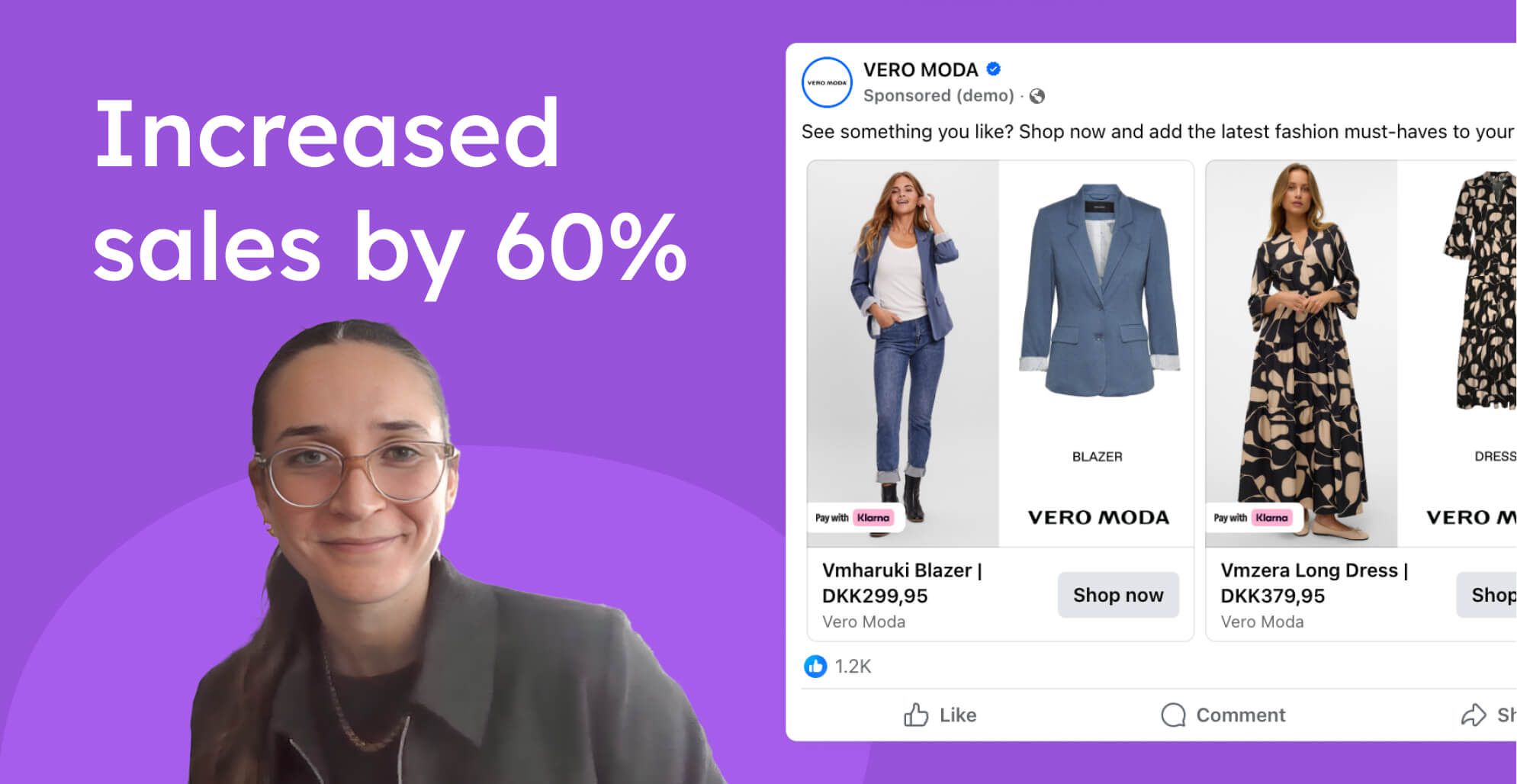
Vero Moda is a global women's fashion brand that is represented in 45 countries and has more than 500 retail stores. It is one of the biggest brands of the Bestseller group.
Paid social is a big marketing channel for them and, as most ecommerce companies, their Catalog Ads started out looking like this:
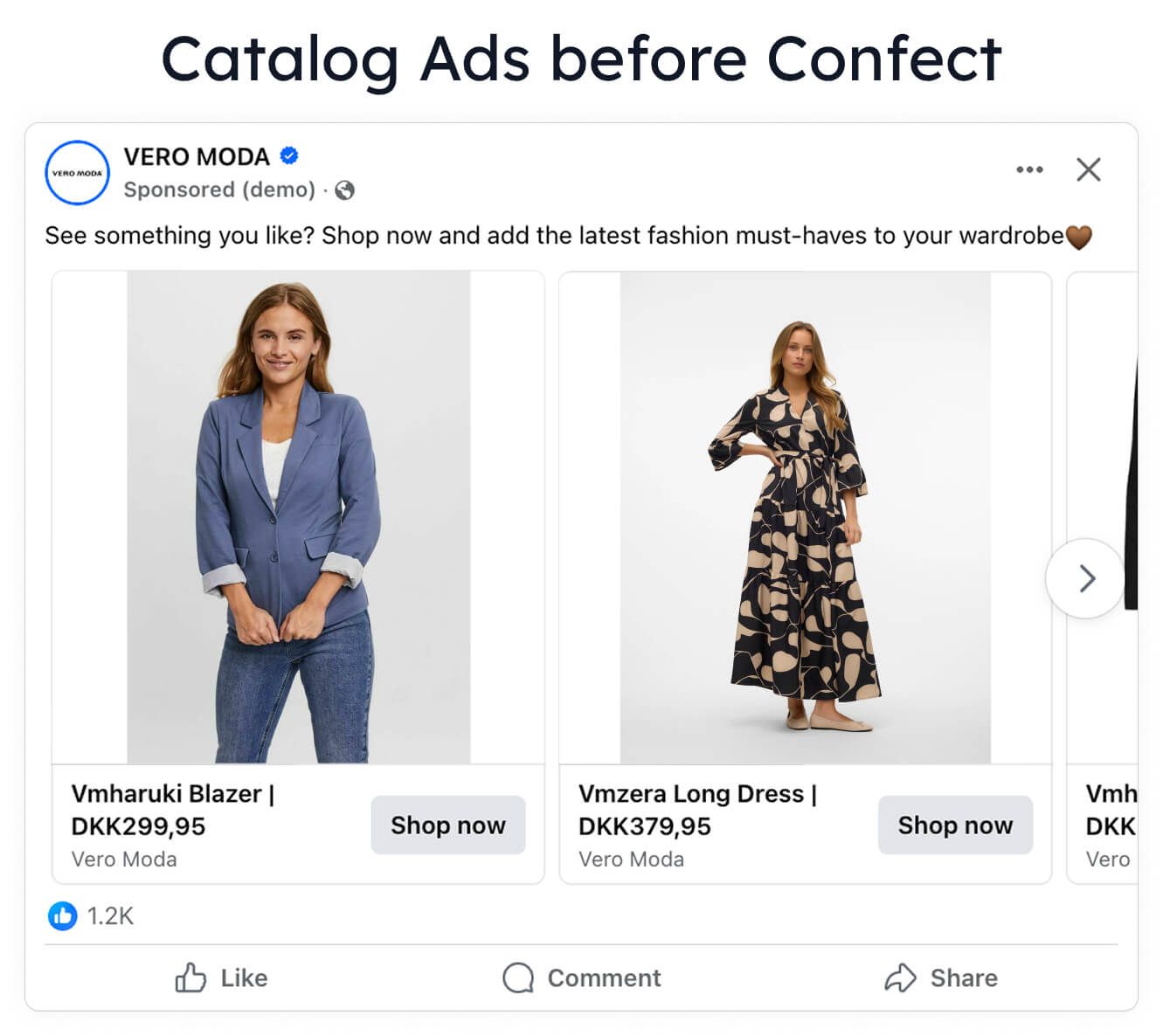
Vero Moda has made a superior Catalog Ads setup with Confect. Their use of Catalog Ads when it comes to testing and using data, using Meta's newest features, and personalizing designs for different audiences is something all e-commerce companies should learn from.
We spoke with Vero Moda's Social Media Manager, Karoline Meldgaard, about how they are using Catalog Ads with Confect.
Their results using Confect for their Catalog Ads
Karoline shared 4 important tactics they implemented via Confect that helped them achieve these impressive results.
Let's dive into some of the tactics Vero Moda are using in their Catalog Ads.
Testing multiple designs to find the best performers
Vero Moda wanted to make sure their catalog ads showed products in the best way to boost engagement and sales. By testing different layouts, and different pieces of product information, they found the most effective design elements and learned which parts performing the best.
At first, Vero Moda's Catalog Ads mostly used model images for the lifestyle look. As they went on, they tested different combinations—showing pack shots instead, two model images, and a mix of a model and a pack shot. The best results came from using both a model image and a pack shot together.
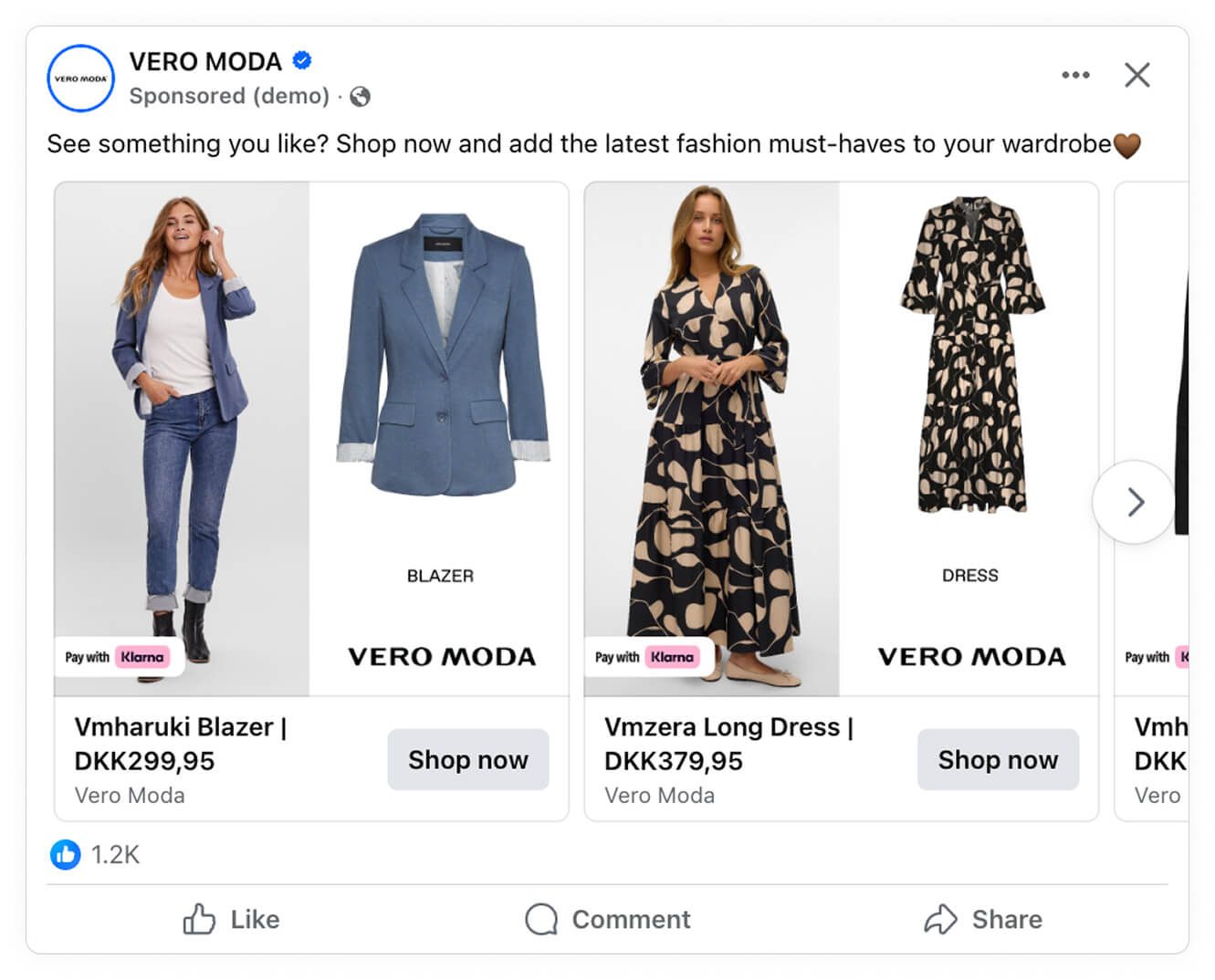
This format gave shoppers a full view of the product—showing how it looks on a person and on its own. The pack shots helped highlight details that might not be clear in a model image, while the model image showed how it could be styled.
Vero Moda also experimented with the information in their ads. One key learning was that clearly stating the product category (like "blazer" or "dress") made a big difference compared to other information like the name.
They even tested which types of lifestyle images that performed the best - and in which scenarios certain types of lifestyle images performed the best.
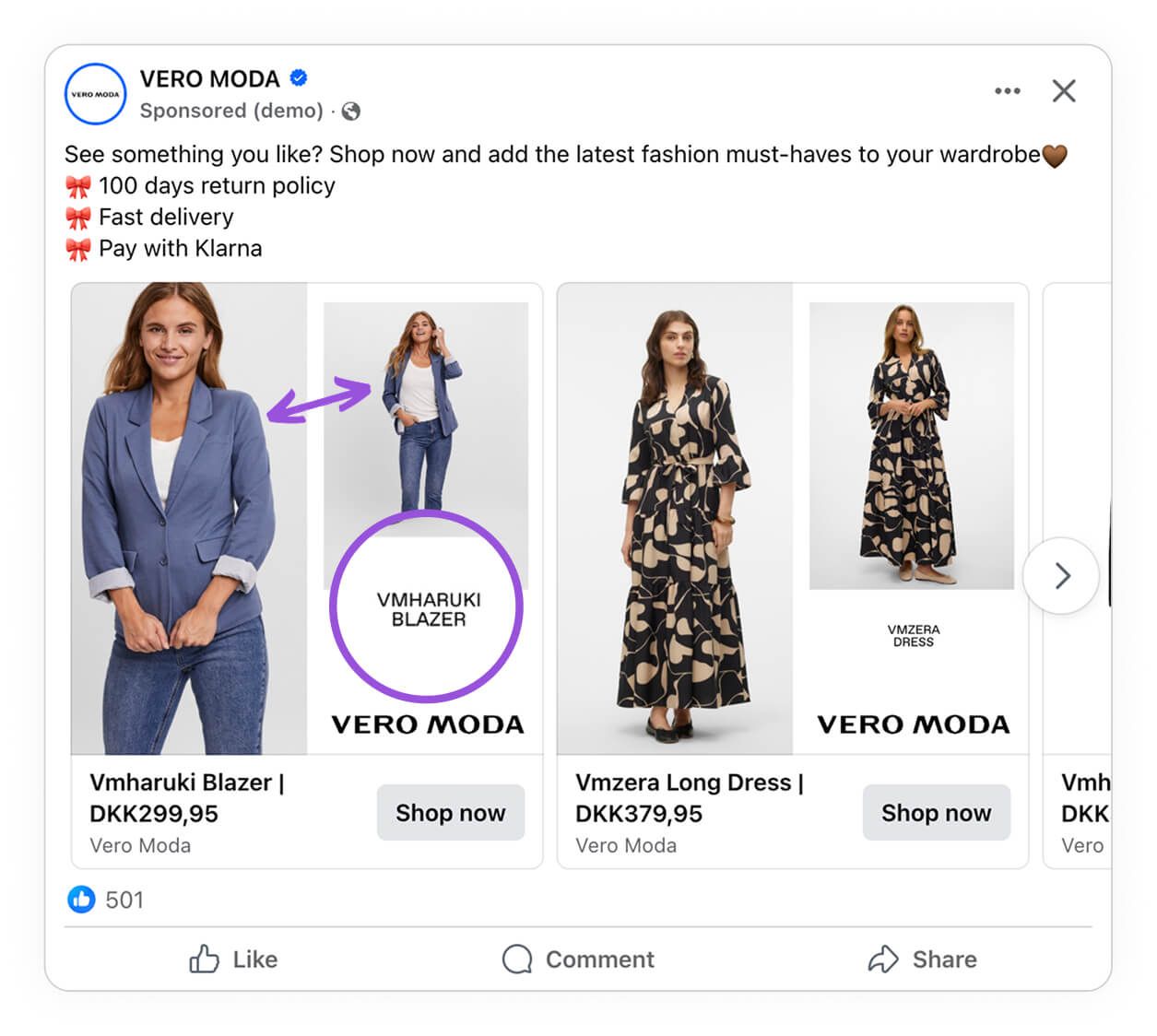
Another test was whether showing the price in the ad image made a difference. Surprisingly, ads without the price did better. Since the price was already in the headline, removing it from the image reduced clutter and kept the focus on the product.
This helped them refine their strategy—first catching attention with the product, then letting customers check the price when they were interested in the ad headline.
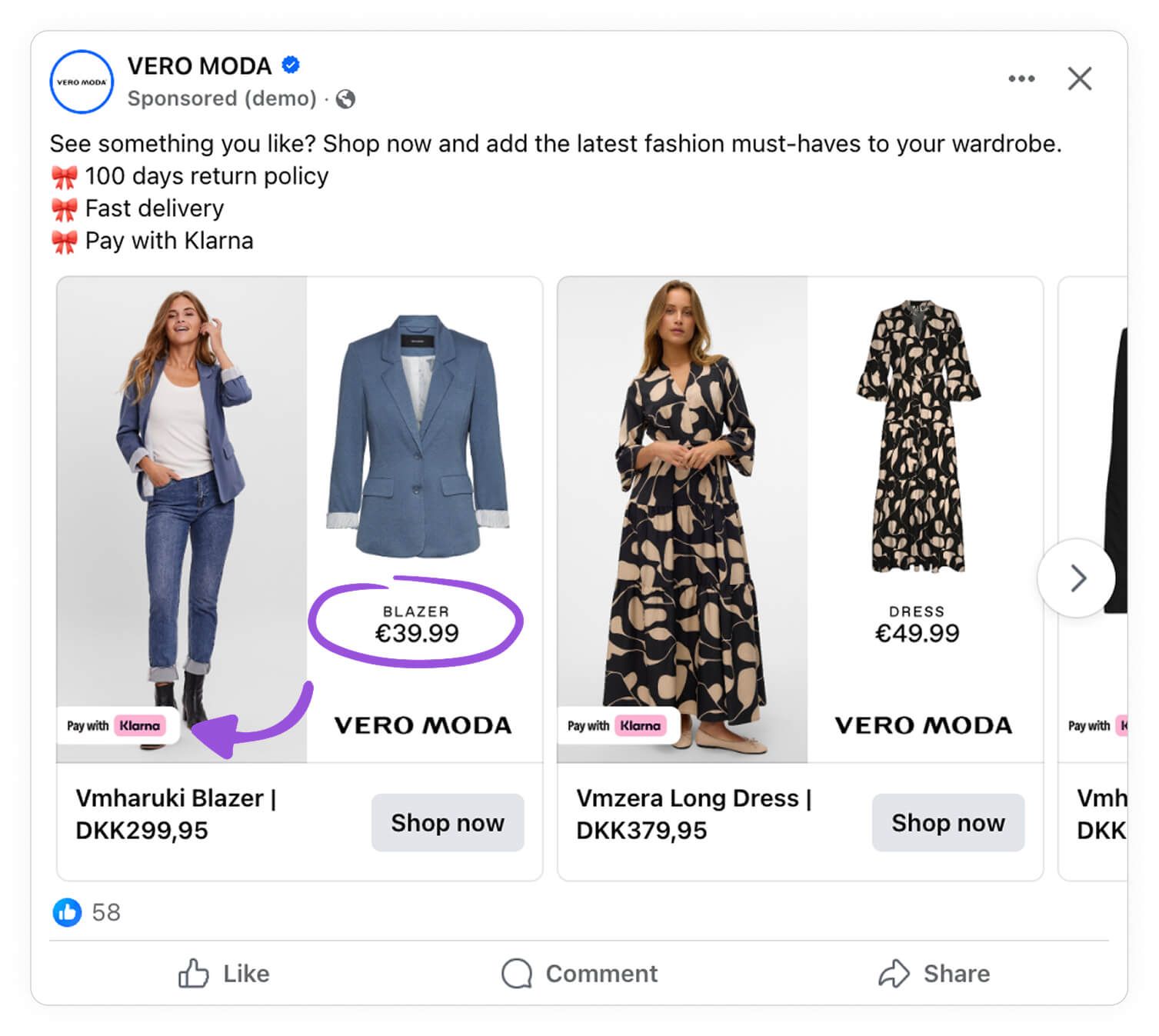
By constantly testing and improving, Vero Moda has found the right mix of visuals and messaging to make their ads more effective. Learning from customer behavior and adjusting quickly has helped them succeed in both new and existing markets.
A great learning from Vero Moda is how they tested different hypotheses at different times - starting with the most impactful changes:
- First testing the most impactful elements, like different types of product images
- Then testing the second-most impactful elements, like showing price or other product information
- Then testing less impactful elements, like showing different payment methods
Always testing in order to answer the most important question:
What is the most relevant information to tell our consumers in our Catalog Ads, and how should we tell them?
 Karoline Meldgaard
Social Media Manager @ Vero Moda
Karoline Meldgaard
Social Media Manager @ Vero Moda
Personalizing Catalog Ads for different audiences and sub brands
Vero Moda has a diverse customer base, and instead of using a one-size-fits-all approach, they optimize their catalog ads for different audiences.
By advertising sub-brands—Vero Moda Girl, Vero Moda Curve, and Vero Moda Maternity among others—they ensure that every shopper finds relevant products with the right information.
For Vero Moda Girl, the focus is on making it clear that the products are for younger customers. The ads include an age range (6-16 years) to instantly communicate who the clothing is for.
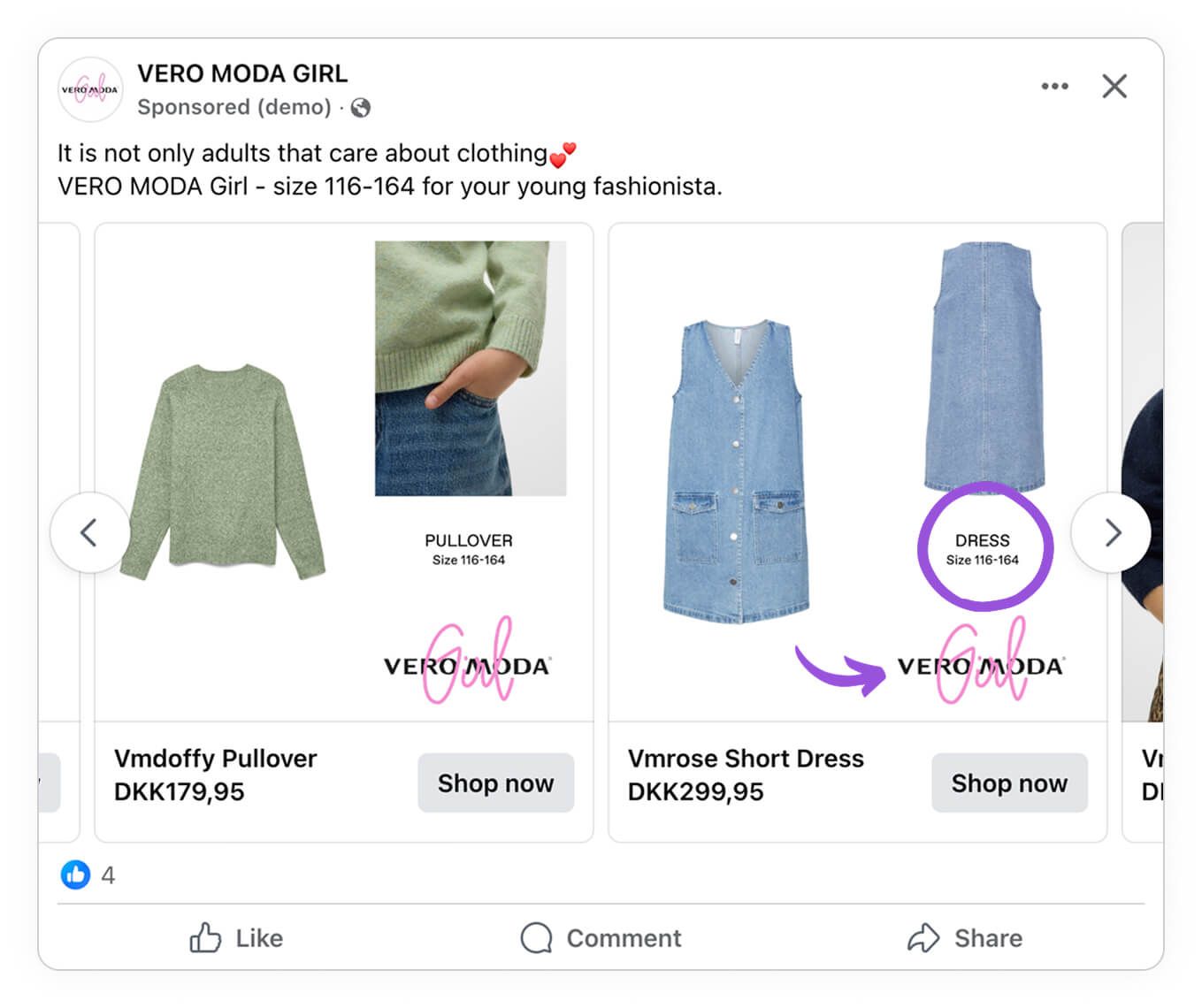
They also very much highlight the sub-brand logo with the pink Vero Moda Girl logo, which really stands out with the pink handwritten font in an otherwise simple design.
This prevents confusion for consumers liking a product based on the product image, only to click and find out on the product page that it is for girls, not adults.
Including size information and sub-brand logos directly in the ad helps ensure a smoother shopping experience.
They are doing the same for Vero Moda Curve products, highlighting which audience this product is for:
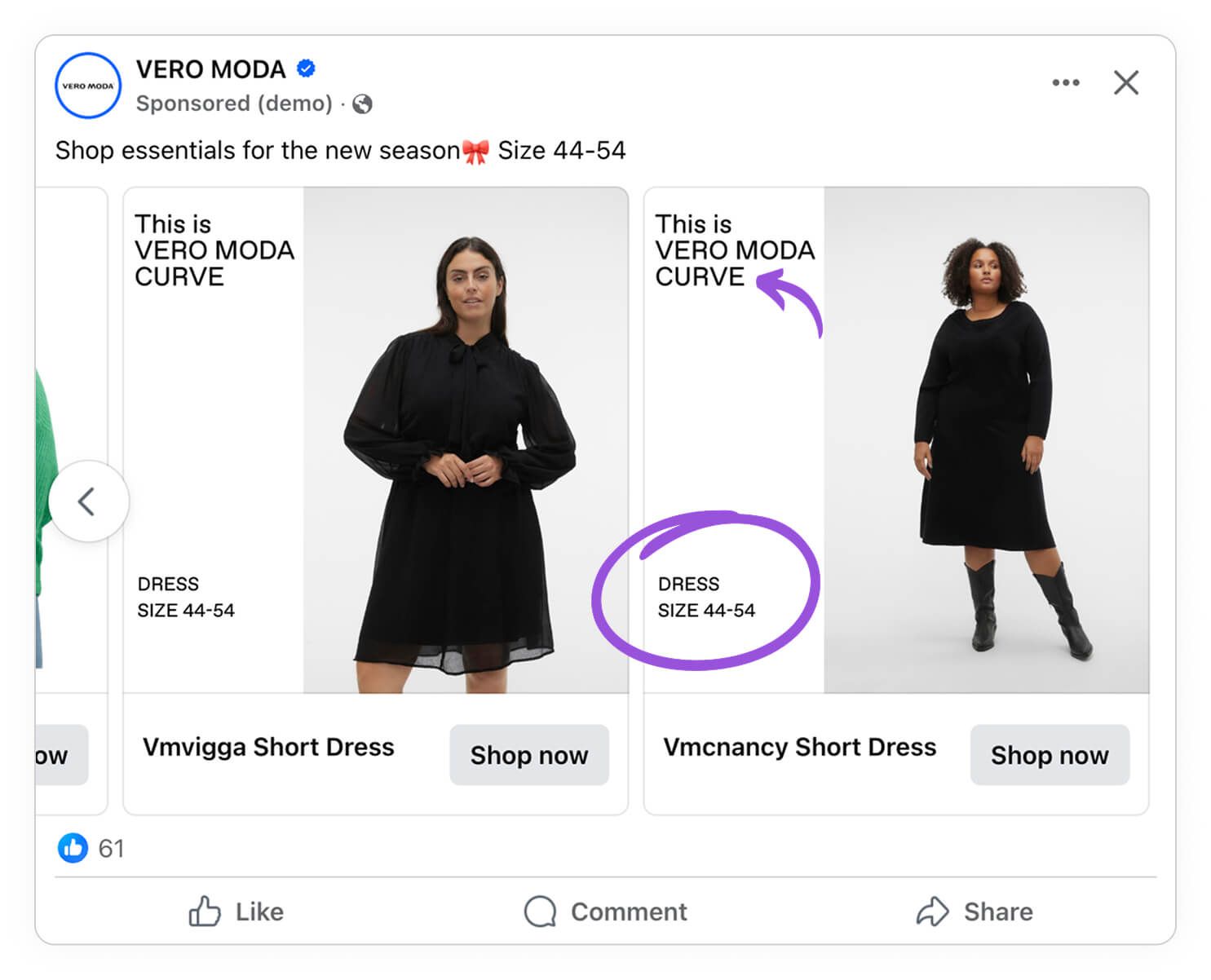
Vero Moda Curve is designed for shoppers who need larger sizes, so the ads prominently display the size range (44-54). This small but powerful addition reassures customers that these clothes are made specifically for their body type.
By making this clear upfront, shoppers can instantly see that these products are for them, leading to a more confident and seamless buying experience.
Over time Meta's algorithms quickly learn who to target with these Curve products - and who not to target.
While the most relevant information is different for consumers shopping for maternity clothing:
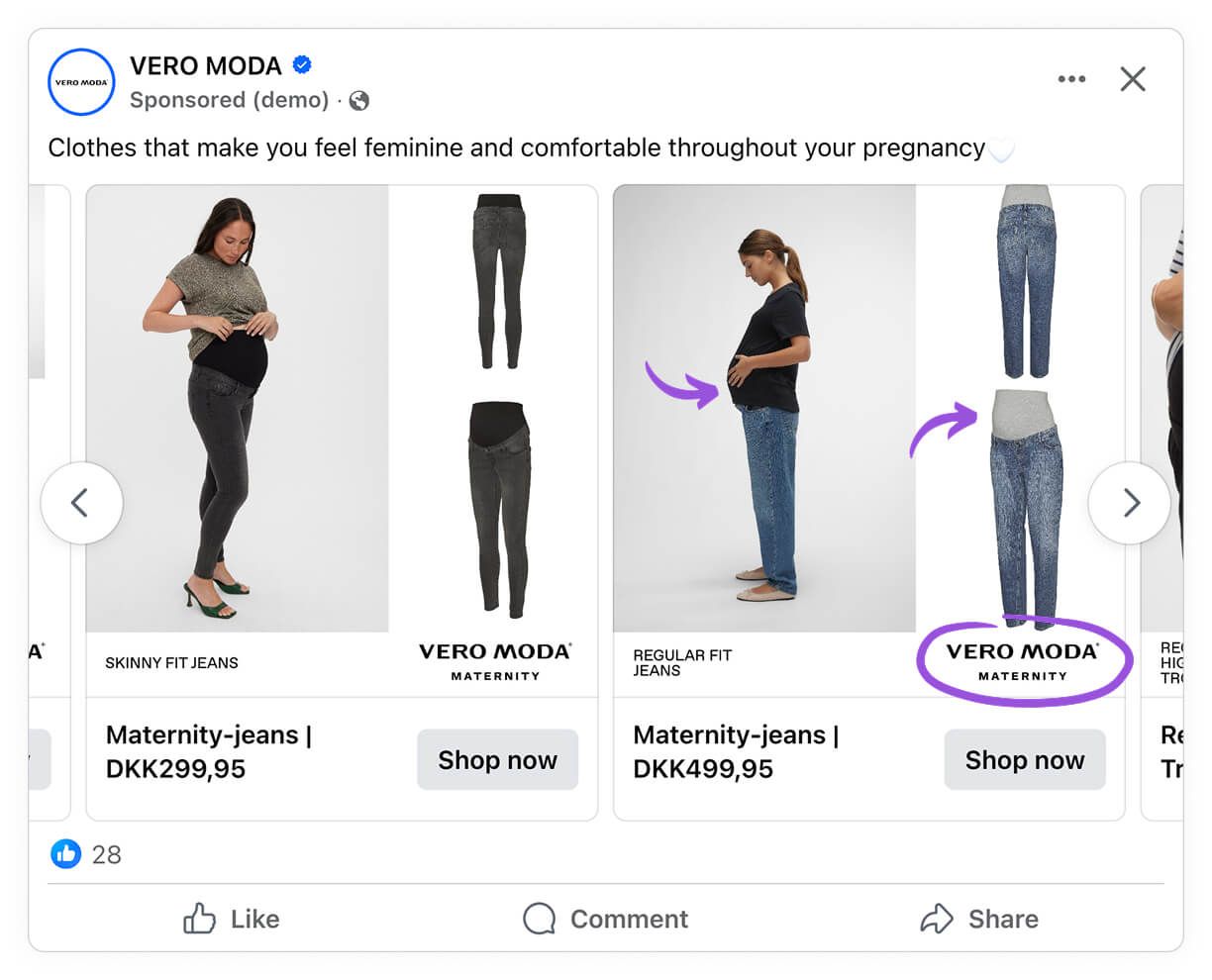
Pregnant customers need clothing with added functionality. Vero Moda Maternity Catalog Ads highlight features such as adjustable waistbands, stretchable fabrics, and nursing-friendly designs.
Instead of just showing the clothes, the ads include multiple images to demonstrate how these features work.
This helps expecting mothers understand why maternity-specific clothing is better than just sizing up, making them more likely to choose these products.
Vero Moda again very much highlight who this Catalog Ad is for - and who it is not for.
By tailoring their catalog ads to each sub-brand, Vero Moda ensures customers quickly see if a product is relevant to them or not.
This approach also helps Meta’s algorithm learn who the right audience is for each ad, improving targeting and overall ad performance.
Their success highlights the power of making shopping easier by providing the right information, to the right audience, at the right time.
A great use case of Catalog Ads.
 Karoline Meldgaard
Social Media Manager @ Vero Moda
Karoline Meldgaard
Social Media Manager @ Vero Moda
Scaling Sales and Campaigns with Catalog Ads
Vero Moda has refined its approach to sales promotions by leveraging dynamic catalog ads. Instead of creating new campaigns and ads for each sale, they integrate sale messaging directly into their existing catalog ads.
This ensures that sale products are highlighted effectively without disrupting restarting Meta's learning phase, leading to better reach and performance.
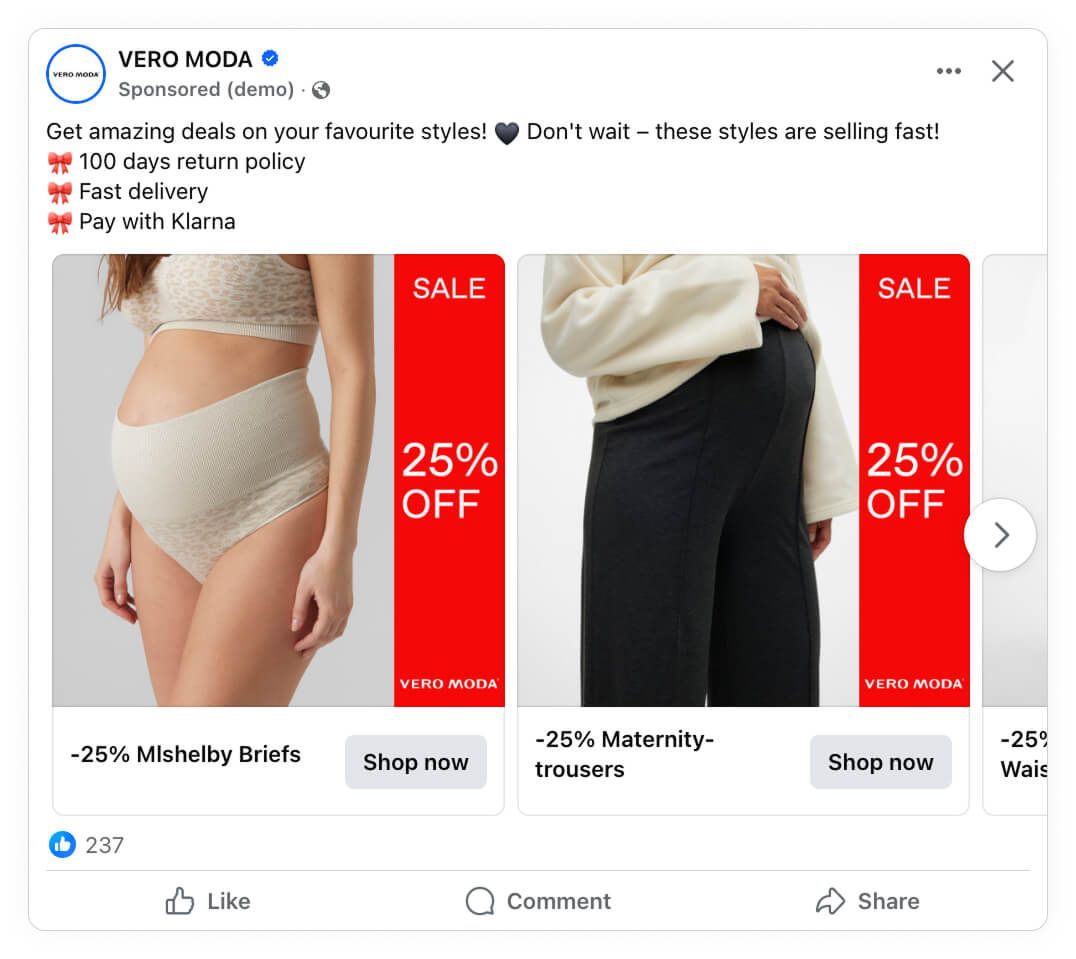
Vero Moda’s sales strategy includes both long-running promotions and short-term offers, such as weekend discounts.
In the past, launching a two-day sale campaign was difficult, as Meta’s algorithm would take too long in the Learning Phase.
Now, instead of creating new campaigns, Vero Moda can simply update the design in their existing ads—adding messages like “Extra 20% Off” or “Final Sale” dynamically.
This ensures that the Catalog Ads updates their messaging without restarting Meta’s learning phase.
A great example of this can be seen in their Story Catalog Ads below, with the discount shown together with a temporary voucher code giving 20% extra off:
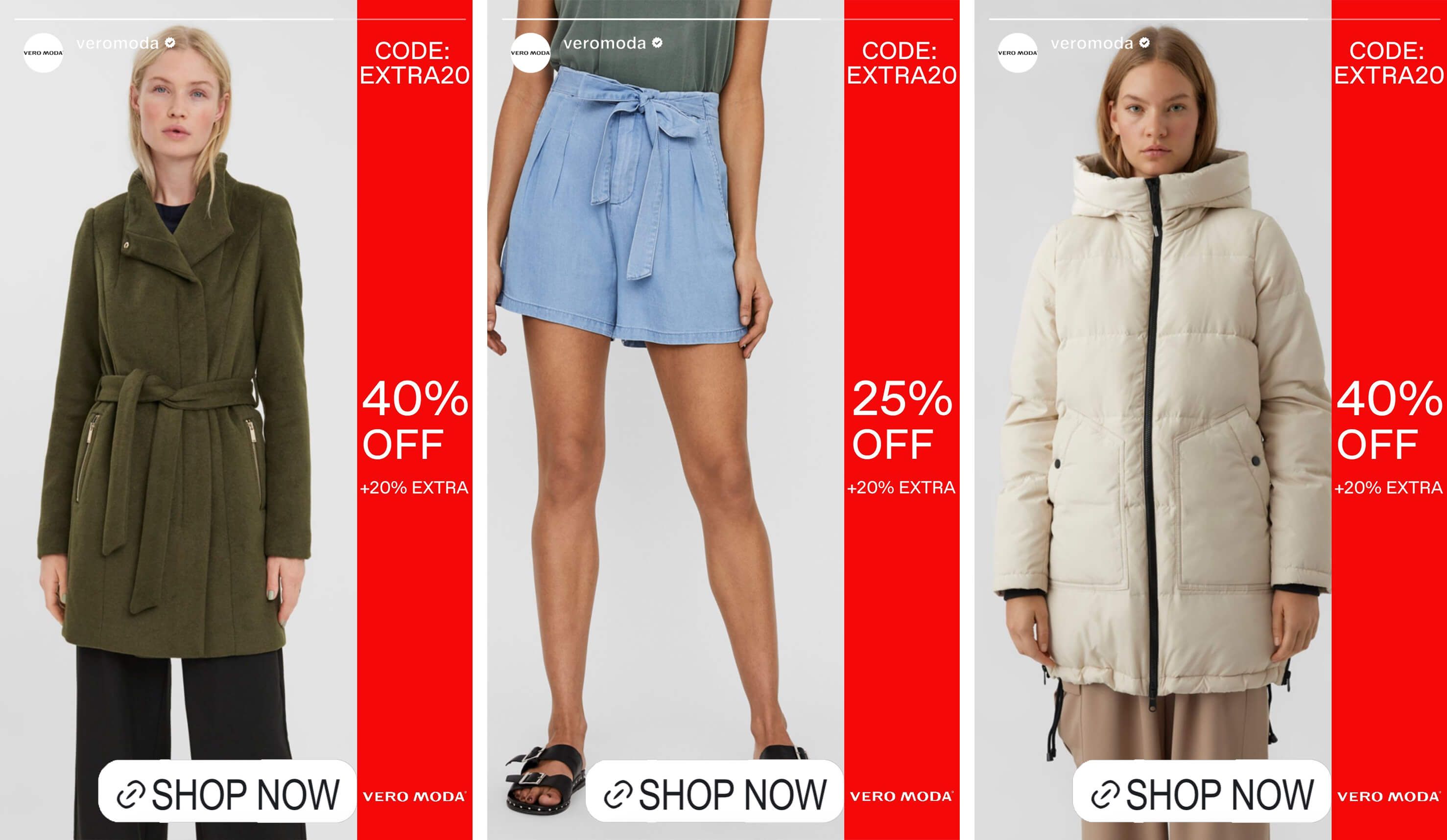
Sale ads need to be attention-grabbing yet consistent with Vero Moda’s brand identity. The brand’s art directors have designated red as the official sale color, ensuring that sale ads maintain a familiar and recognizable look while standing out in a crowded feed.
By keeping these visual guidelines intact, Vero Moda balances performance-driven design with brand consistency, even for sale campaigns.
For broader sale campaigns, Vero Moda also uses collection ads that feature an overall sale message at the top with individual product discounts below.
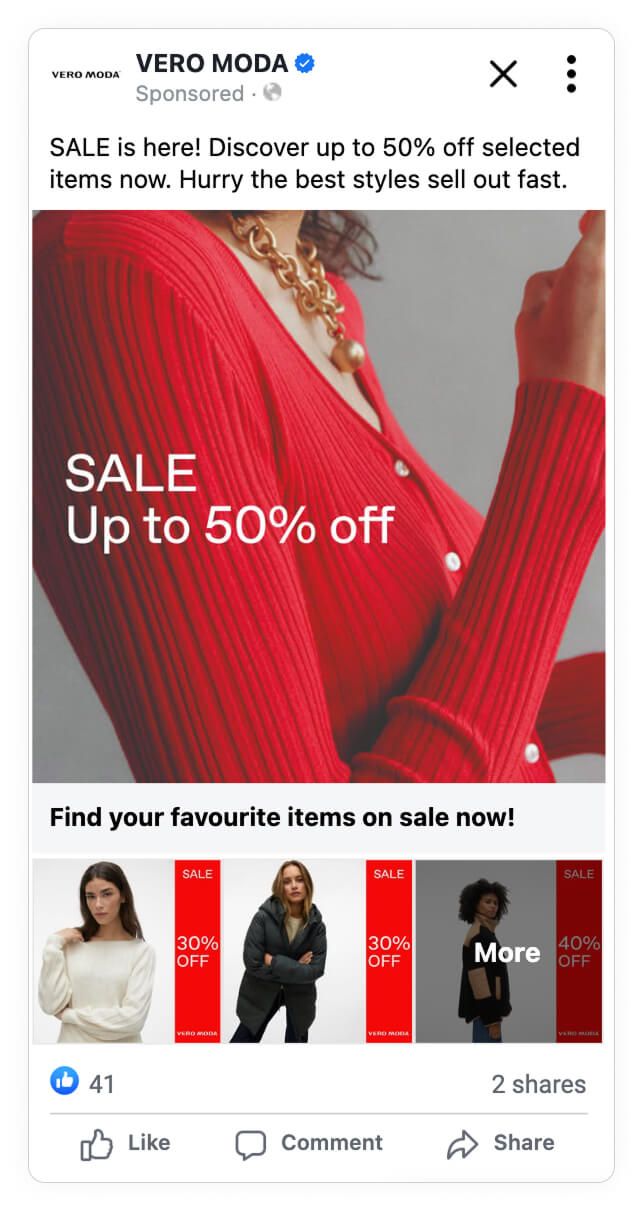
This approach blends strong branding with specific product offers, making it easier for customers to see both the big-picture sale event and the exact savings available on each item.
By making sales messages dynamic and updating their Catalog Ads accordingly, Vero Moda has significantly improved its ad performance.
And the best thing of all? This is all automated by scheduled design rules that automatically turn sale designs on and off based on the sale period.
Through these optimizations, Vero Moda has found a way to run sales efficiently, maximize conversions, and maintain a strong brand presence, all while reducing the manual effort of launching new campaigns for every short-term sale.
 Karoline Meldgaard
Social Media Manager @ Vero Moda
Karoline Meldgaard
Social Media Manager @ Vero Moda
Not only optimizing for performance and ROAS
Vero Moda recently refined its approach to showing product names in catalog ads, shifting from describing names like "blazer with long sleeves" or "flower long dress" to using specific style names like "VMHARUKI blazer".
This change was driven by a key consumer behavior insight: many shoppers screenshot ads or save links to search for products later, often using Google.
By including the exact style name in their ads, Vero Moda makes it easier for consumers to find and purchase the items they discover on social media.
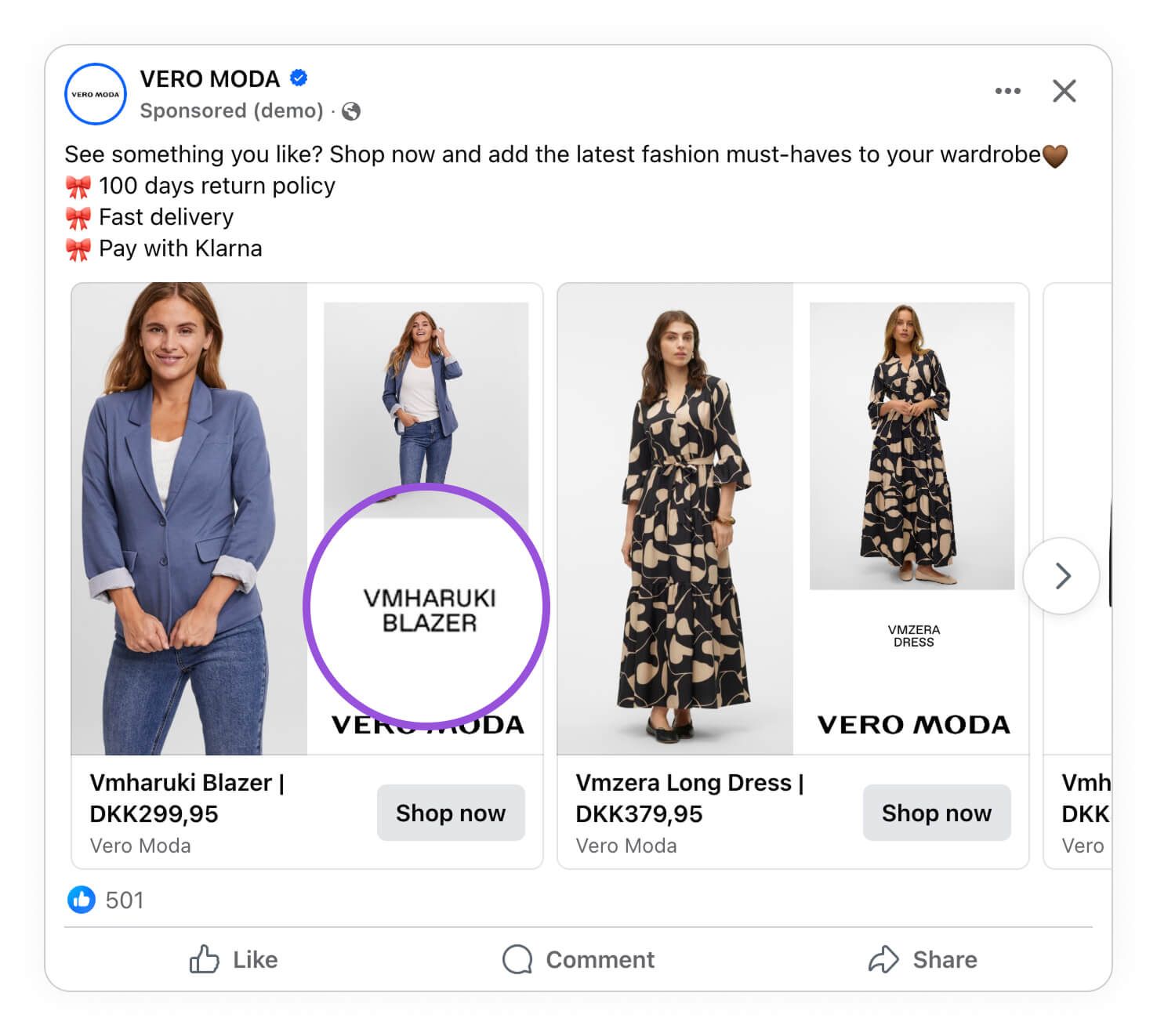
By adding specific style names, Vero Moda ensures that when customers search for a product later—whether on Google or the brand’s website—they find exactly what they saw in the ad.
Previously, searches for broad terms like “blue blazer” or “printed dress” meant competing with many other retailers. But when consumers search for “VMHARUKI blazer”, Vero Moda can capture almost all those searches, significantly increasing their chances of winning the purchase.
 (1).jpg)
To confirm this strategy’s effectiveness, Vero Moda conducted a Meta conversion lift study.
The results showed a 25% increase in both generic and shopping-related Google searches from users exposed to Vero Moda’s Meta ads.
This provided clear proof that social media inspiration drives search activity, reinforcing the connection between seeing a Catalog Ad on Facebook or Instagram, and then searching days later in order to actually buy the product.
Vero Moda’s goal isn’t just to encourage immediate purchases—it’s also about making future purchases effortless.
By reducing the friction between initial inspiration and final conversion, they capture more customers who take time to decide. Whether someone buys right away or searches days later, ensuring they can quickly find the product again has been a game-changer for sales and conversion rates.
 Karoline Meldgaard
Social Media Manager @ Vero Moda
Karoline Meldgaard
Social Media Manager @ Vero Moda
Conclusion
Vero Moda’s success with Catalog Ads and Confect highlights the power of data-driven, personalized advertising.
By optimizing the designs of their Catalog Ads, testing the most impactful product information to show, tailoring ads to different audience segments, and dynamically adjusting sale messaging, they significantly boosted engagement and conversions.
Their ability to adapt to customer behavior—such as adding style names to improve searchability—further enhanced their impact.
With a 46% increase in traffic and 60% growth in sales, their approach proves that smart testing and automation drive real business results.
Vero Moda’s strategy is a blueprint for any e-commerce brand looking to refine its Catalog Ads for better performance, relevance, and efficiency.
